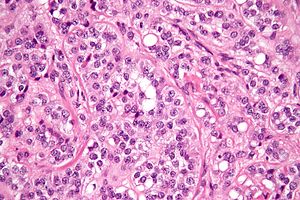
Sertoli cell tumour
| Sertoli cell tumour | |
|---|---|
 | |
| Micrograph of a Sertoli cell tumour. H&E stain. | |
| Specialty |
Oncology |
A Sertoli cell tumour, also Sertoli cell tumor (US spelling), is a sex cord-gonadal stromal tumor of Sertoli cells. They can occur in the testis or ovary. They are very rare and generally peak between the ages of 35 and 50. They are typically well-differentiated, and may be misdiagnosed as seminomas as they often appear very similar.
A tumor that produces both Sertoli cells and Leydig cells is known as a Sertoli–Leydig cell tumor.
Presentation
In males, Sertoli cell tumours typically present as a testicular mass or firmness, and their presence may be accompanied by gynaecomastia (25%) if they produce oestrogens, or precocious pseudopuberty in young boys, especially if they produce androgens.
Diagnosis
On ultrasound, a Sertoli cell tumour appears as a hypoechoic intratesticular lesion which is usually solitary. However, the large cell subtype might present as multiple and bilateral masses with large areas of calcification. An MRI may also be conducted, but this typically is not definitive.
Microscopy and immunohistochemistry are the only way to give a definitive diagnosis, especially when there is a suspected seminoma.
Treatment
In males, due to the difficulty in identifying the tumour using imaging techniques, an orchiectomy is often performed. The majority of Sertoli cell tumours are benign, so this is sufficient. There is no documented benefit of chemotherapy or radiotherapy.
In non-humans
Sertoli cell tumors are known to occur in other species, including domestic ducks, dogs, and horses.
Additional images
Micrograph of a Leydig cell tumour
See also
External links
-
 Media related to Sertoli cell tumor at Wikimedia Commons
Media related to Sertoli cell tumor at Wikimedia Commons


